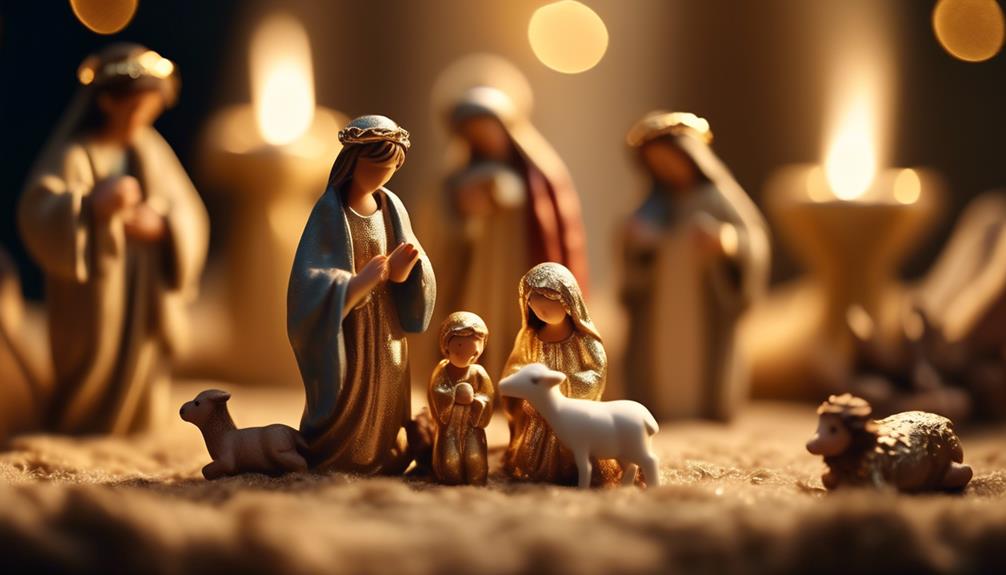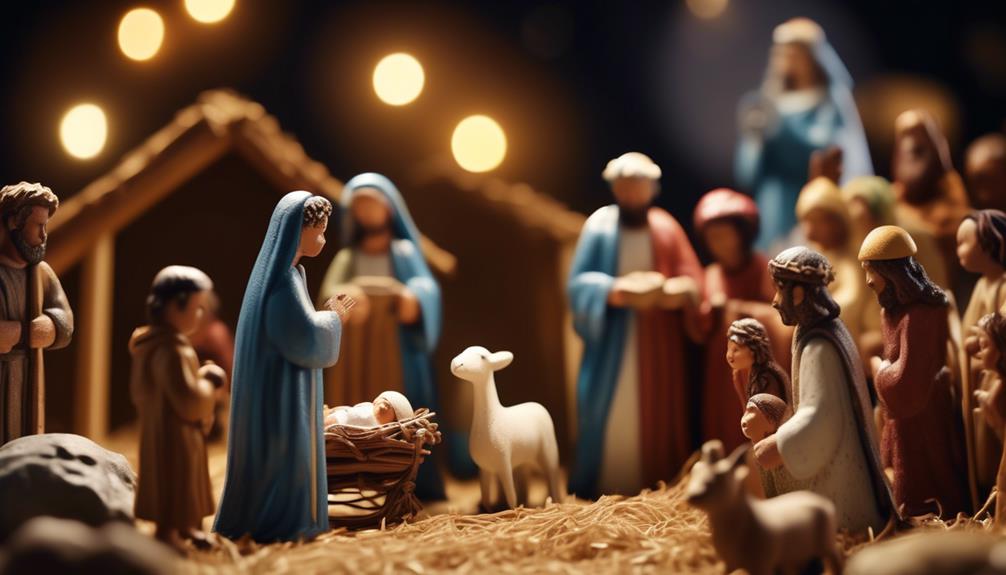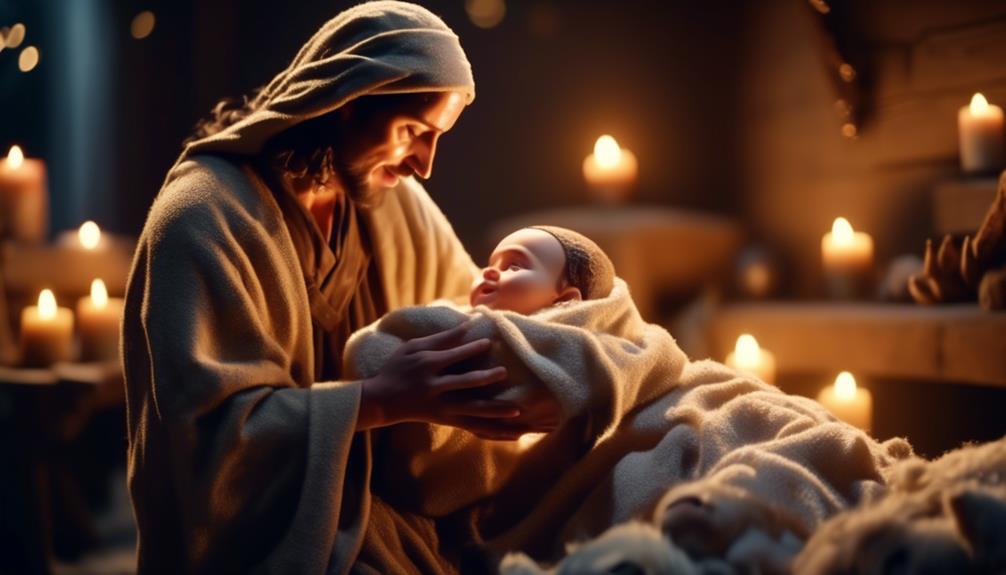The Nativity, a significant event in Christian tradition, holds a place of prominence in the hearts and minds of believers worldwide. Its portrayal through various art forms, from paintings to sculptures, continues to captivate audiences and evoke a sense of wonder. But what makes the Nativity so enduring and cherished? Beyond its historical importance and religious symbolism, the Nativity holds a universal appeal that transcends boundaries of faith and culture. In this discussion, we will explore the multifaceted reasons behind the enduring fascination with the Nativity, inviting readers to uncover the deeper meaning and relevance that this timeless story holds for humanity.
Key Takeaways
- The Nativity is a historically and culturally significant event that marks a new era for Christianity.
- The Nativity is deeply embedded in the cultural heritage of communities worldwide, with diverse customs and traditions associated with its celebration.
- The Nativity represents birth of hope, peace, and salvation for humanity, with powerful symbolism and universal appeal.
- The Nativity holds a central place in Christian beliefs, reflecting core values of the faith and resonating with people of all backgrounds.
Historical Significance

The historical significance of the Nativity lies in its role as a pivotal event in the religious and cultural history of Christianity. To understand this significance, it is important to examine the historical context in which the Nativity took place and the biblical accuracy of the accounts.
In terms of historical context, the Nativity occurred during the reign of King Herod the Great, in the small town of Bethlehem. At this time, the region was under Roman rule, and the Jewish people were eagerly awaiting the arrival of a Messiah who would deliver them from oppression. The birth of Jesus, as described in the Bible, fulfilled these expectations and marked the beginning of a new era for Christianity.
The biblical accuracy of the Nativity accounts has been a subject of debate among scholars. While some critics argue that the story is a mere legend or myth, many historians and theologians affirm its authenticity. The Gospels of Matthew and Luke provide detailed narratives of the Nativity, including the visit of the Magi, the shepherds in the fields, and the birth in a manger. These accounts, although differing in some details, consistently emphasize the central message of Jesus' birth as the fulfillment of Old Testament prophecies and the inauguration of God's redemptive plan for humanity.
The historical significance of the Nativity cannot be understated. It represents the birth of Jesus, the central figure of Christianity, who would go on to teach, heal, and ultimately sacrifice himself for the salvation of humanity. The Nativity serves as a foundational event that shapes the beliefs, traditions, and celebrations of Christians around the world, making it a crucial moment in both religious and cultural history.
Symbolism and Representation
Having established the historical significance of the Nativity, it is now imperative to explore the profound symbolism and representation inherent in this pivotal event. The Nativity holds a deep symbolic meaning that transcends its historical context. It represents the birth of hope, peace, and salvation for humanity. The arrival of Jesus Christ, the Son of God, in humble circumstances, encapsulates the idea of divine intervention in the midst of human suffering and vulnerability. The symbolism of the Nativity is further enhanced through artistic interpretations.
Artistic representations of the Nativity have evolved over the centuries, reflecting the cultural and religious beliefs of different societies. Paintings, sculptures, and nativity scenes have captured the essence of this event, showcasing the symbolism behind each element. The presence of the Virgin Mary, Joseph, the shepherds, and the wise men all contribute to the symbolism of unity, faith, and the universal nature of Christ's message.
The Nativity scene itself, with the stable, the manger, and the animals, symbolizes simplicity, humility, and the willingness to embrace a higher purpose. It serves as a reminder that greatness can emerge from the most humble beginnings. The star that guided the wise men to the birthplace of Jesus represents divine guidance and enlightenment.
These artistic interpretations of the Nativity go beyond mere visual representations. They invite individuals to reflect on the deeper meaning of this event and its relevance to their own lives. The symbolism and representation of the Nativity are not confined to a specific time or place; they resonate with people of different cultures and backgrounds, reminding them of the universal message of love, hope, and redemption that the birth of Jesus brings.
Connection to Christian Faith

The Nativity holds profound significance within the Christian faith as it represents the central event of Christ's birth and the foundation of the Christian belief system. The faith connection and spiritual significance of the Nativity are essential elements that shape the beliefs and practices of Christians around the world. Here are four key reasons why the Nativity is so important to the Christian faith:
- Incarnation of God: The Nativity portrays the belief that God took on human form in the person of Jesus Christ. This miraculous event is seen as the ultimate act of love and sacrifice, demonstrating God's desire to connect with humanity on a personal level.
- Redemption and Salvation: The Nativity is intricately linked to the Christian understanding of redemption and salvation. Christians believe that through the birth of Jesus, God's plan for the salvation of humanity was set into motion. The Nativity marks the beginning of God's ultimate act of love and grace, leading to the crucifixion and resurrection of Jesus.
- Fulfillment of Prophecy: The birth of Jesus in Bethlehem fulfilled numerous prophecies found in the Old Testament. Christians see this as evidence of God's faithfulness and the divine nature of Jesus. The Nativity serves as a powerful reminder that God's promises are always fulfilled.
- Hope and Joy: The Nativity story is one of hope and joy. It reminds Christians of the hope they have in Christ and the joy that comes from knowing that God is with them. The birth of Jesus brings a message of peace, love, and reconciliation, offering believers a renewed sense of purpose and meaning in life.
The Nativity is much more than a simple historical event; it is a reflection of the core beliefs and values that define the Christian faith. Its spiritual significance lies in the profound connection it establishes between God and humanity, offering believers a source of hope, redemption, and eternal life.
Cultural and Traditional Importance
Centuries-old customs and rituals surrounding the Nativity have established its enduring cultural and traditional importance. The Nativity is not only a religious event but also a significant part of cultural heritage and a festive celebration for many communities around the world. Let's delve deeper into the cultural and traditional aspects of the Nativity.
To fully understand the cultural importance of the Nativity, we can look at the diverse customs and traditions associated with this celebration. These customs vary across different regions and countries, but they all share a common thread of commemorating the birth of Jesus Christ.
To illustrate this, let's take a look at a few examples of Nativity customs and traditions from around the world:
| Country | Custom | Tradition |
|---|---|---|
| Italy | Presepe | Creating intricate nativity scenes, often with elaborate handcrafted figurines. |
| Mexico | Las Posadas | Reenacting Mary and Joseph's search for shelter and hosting neighborhood processions. |
| Philippines | Simbang Gabi | Attending nine consecutive early morning masses leading up to Christmas. |
| Ethiopia | Ganna | Combining religious rituals with traditional games, feasting, and music. |
These examples highlight the diverse ways in which the Nativity is celebrated and cherished worldwide. The Nativity has become deeply embedded in the cultural fabric of communities, serving as a reminder of shared values and traditions.
Furthermore, the Nativity serves as a festive celebration that brings people together, fostering a sense of unity and joy. The colorful decorations, music, and festivities associated with the Nativity create a vibrant and joyful atmosphere. Families and communities come together to participate in these celebrations, strengthening bonds and creating lasting memories.
Universal Appeal and Message

The Nativity's enduring cultural and traditional importance extends beyond specific regions and communities, presenting a universal appeal and message that resonates with people around the world. Here are four reasons why the Nativity has such a universal appeal and message:
- Symbolism: The Nativity is rich in symbolism that transcends cultural and religious boundaries. The story of the birth of Jesus represents hope, love, and the possibility of redemption. These themes resonate with people from all walks of life, making the Nativity a powerful and relatable story.
- Human Connection: The Nativity story focuses on the humble birth of Jesus in a stable, surrounded by Mary, Joseph, shepherds, and wise men. This emphasis on the human experience fosters a sense of empathy and connection among people, regardless of their backgrounds. The message of love, compassion, and the value of every individual resonates universally.
- Faith and Belief: The Nativity holds a central place in Christian beliefs and traditions. However, its message of faith and belief in something greater than oneself can speak to people of all faiths or those who do not identify with any religion. The universal appeal lies in the idea that there is something beyond the material world that gives meaning and purpose to our lives.
- Timeless Relevance: Despite being a story rooted in ancient history, the Nativity's message remains relevant today. Its themes of hope, peace, and the power of love are timeless and can inspire and guide individuals in their personal lives, as well as societies at large. The Nativity's universal appeal stems from its ability to address fundamental human desires and aspirations.
Frequently Asked Questions
What Are the Origins of the Nativity Scene and How Has It Evolved Over Time?
The origins of the nativity scene can be traced back to the birth of Jesus Christ in Bethlehem. It was popularized by Saint Francis of Assisi in the 13th century, who wanted to emphasize the humble and human nature of Jesus' birth. Over time, the nativity scene has evolved and taken on various forms, incorporating different cultural and artistic elements. Today, it is a widely recognized symbol of Christmas and continues to be displayed in churches, homes, and public spaces around the world.
How Does the Nativity Story Relate to Other Religious Traditions and Their Beliefs?
The nativity story holds significance not just within Christianity, but also in relation to other religious traditions and their beliefs. Religious comparisons reveal similarities in the concept of divine birth and the importance of sacred figures. Cultural adaptations of the nativity scene can be seen in various regions, incorporating local customs and traditions. These adaptations reflect the universal appeal of the nativity story and its ability to resonate with diverse religious and cultural backgrounds.
Are There Any Controversies or Debates Surrounding the Nativity Story?
Controversies surrounding the nativity story have arisen due to its various interpretations. One particular point of contention revolves around the historical accuracy of the events depicted. Some scholars argue that the story is a religious myth, while others assert its factual basis. Additionally, debates arise concerning the role and portrayal of certain characters, such as the Magi or the shepherds. These controversies highlight the diversity of perspectives and interpretations surrounding the nativity story, allowing for a rich and thought-provoking discussion.
How Has the Nativity Scene Been Portrayed in Different Forms of Art Throughout History?
Throughout history, the nativity scene has been portrayed in various forms of art, showcasing portrayal variations and incorporating symbolic elements. Artists have used different mediums, such as paintings, sculptures, and stained glass, to depict the birth of Jesus. These artistic representations often include key figures like Mary, Joseph, baby Jesus, the shepherds, and the wise men. Symbolic elements, such as the Star of Bethlehem, angels, and animals, are commonly incorporated to convey the spiritual significance of the nativity story.
What Are Some Popular Customs or Rituals Associated With the Nativity Story in Different Cultures Around the World?
Popular customs and rituals associated with the nativity story in different cultures around the world include gift giving and caroling. These practices vary in their specific traditions and meanings, but they all contribute to the celebration of the birth of Jesus. Gift giving symbolizes the offering of love and gratitude, while caroling brings people together in joyful song. These customs foster a sense of community and reinforce the spiritual significance of the nativity story in diverse cultures globally.
Conclusion
In conclusion, the nativity holds immense historical, symbolic, and cultural significance. Its portrayal of the birth of Jesus Christ resonates with the Christian faith and serves as a testament to the universal appeal of the story. The nativity scene continues to be widely embraced and celebrated, reminding us of the importance of love, hope, and the power of faith. As we gaze upon the anachronistic nativity, we are transported back in time, connecting with a timeless message that continues to captivate audiences today.

